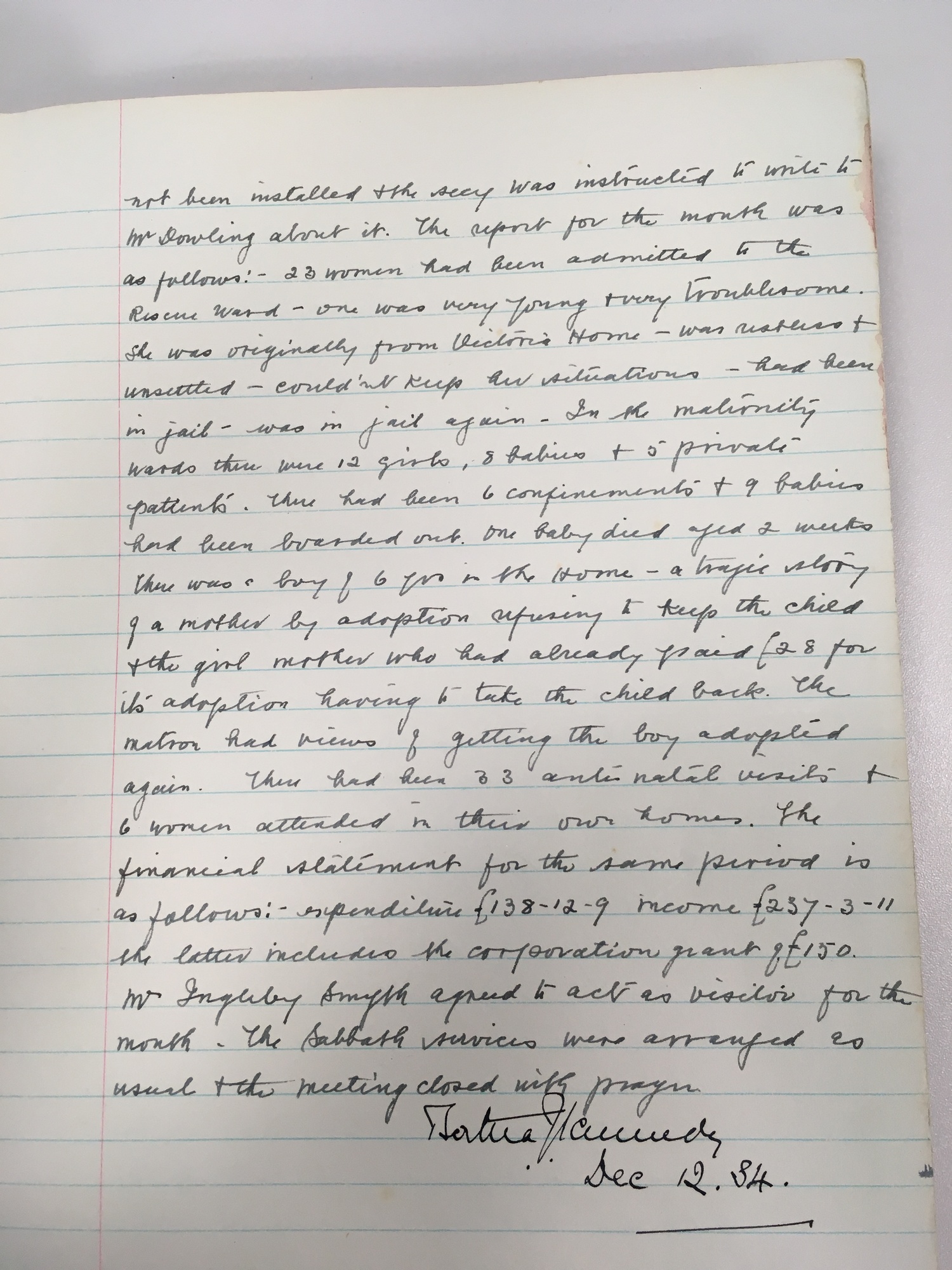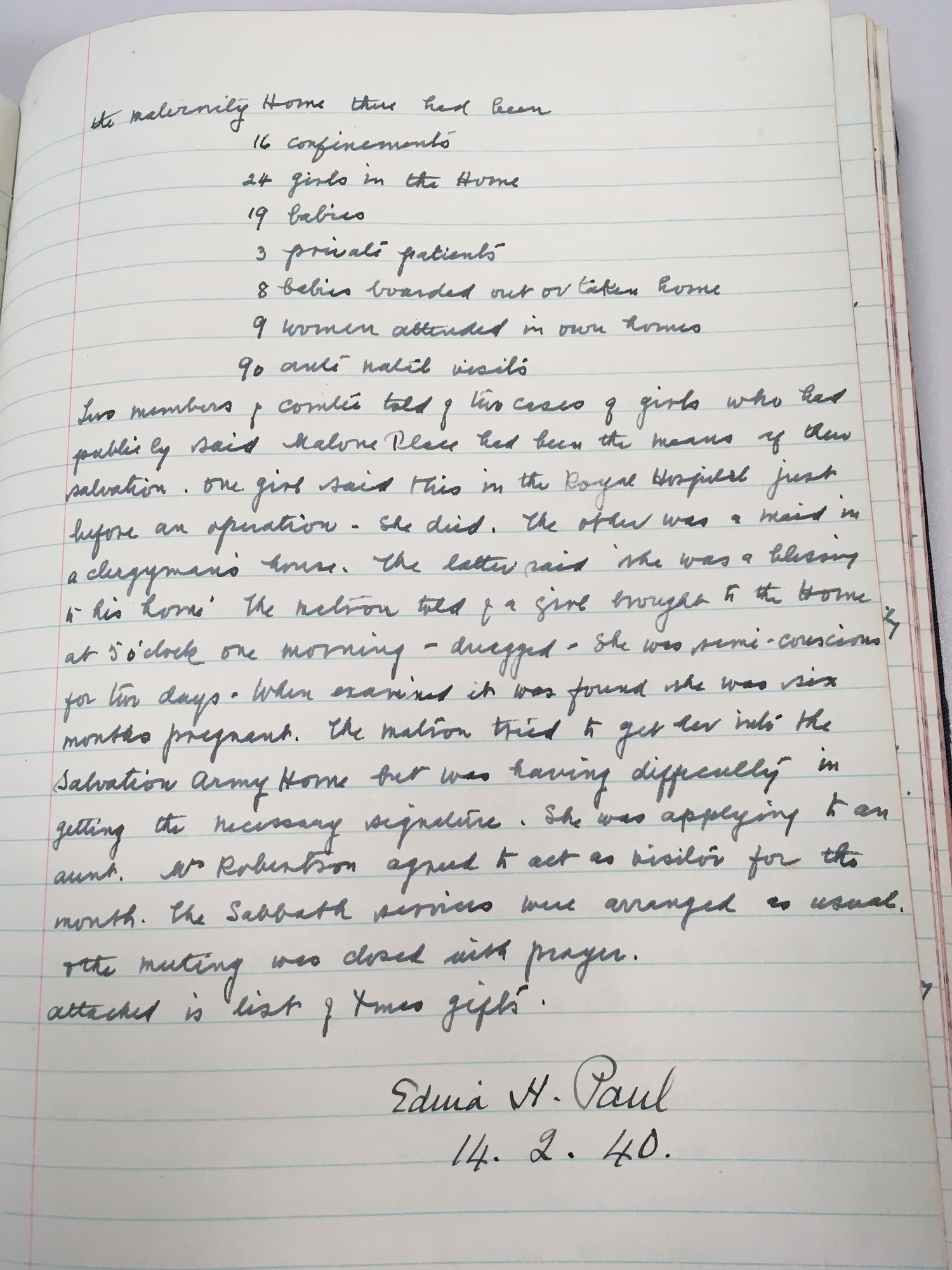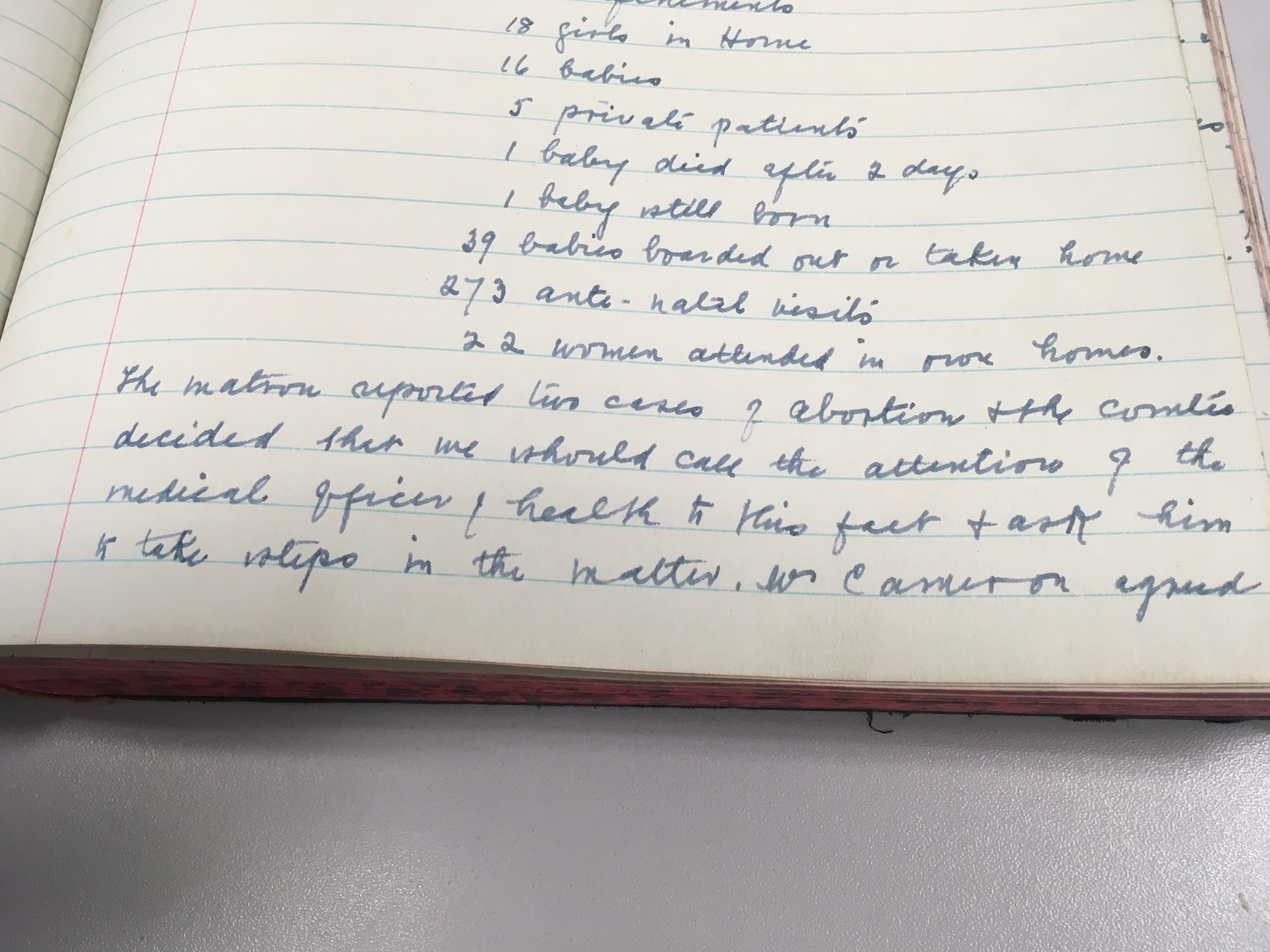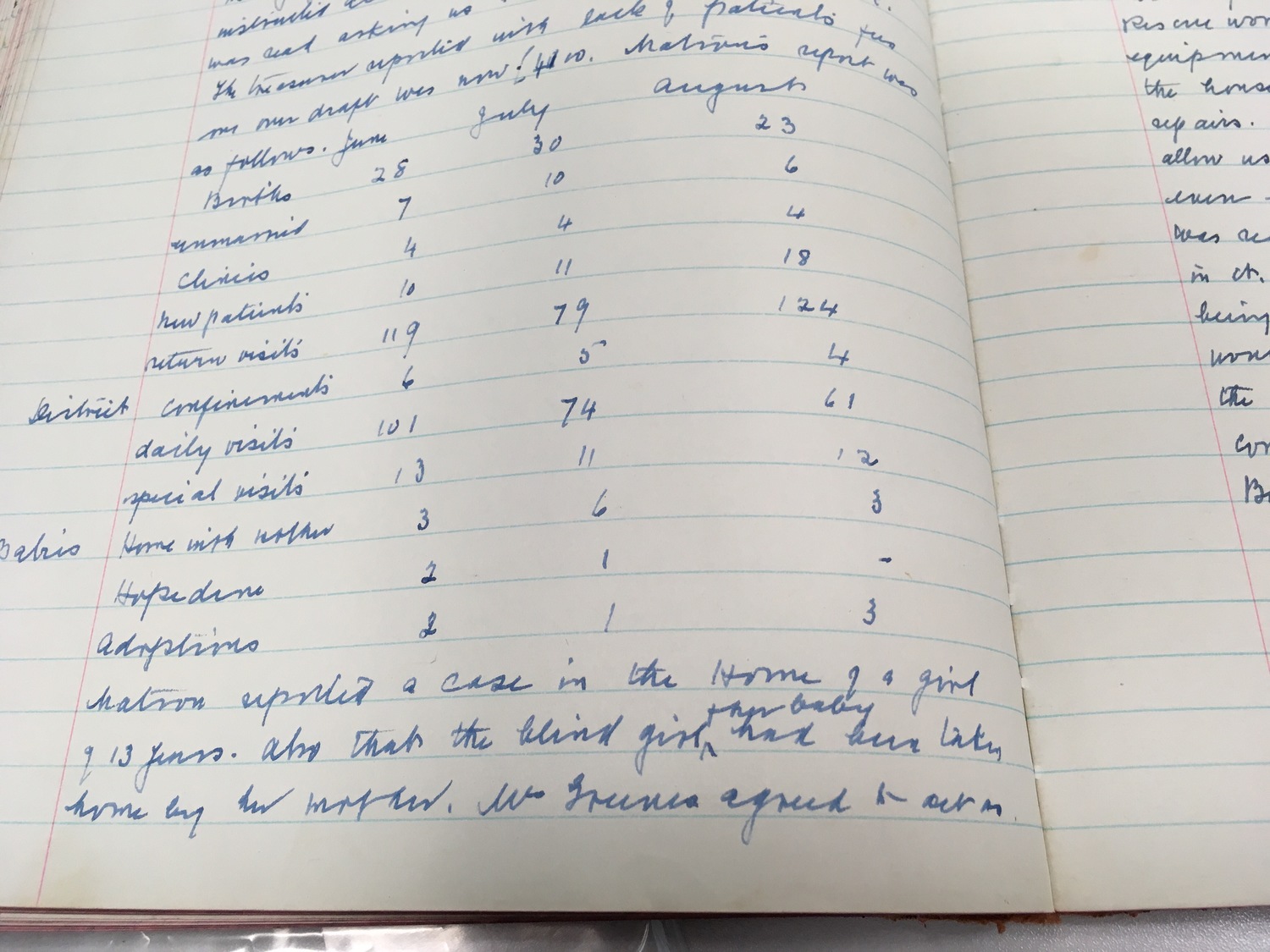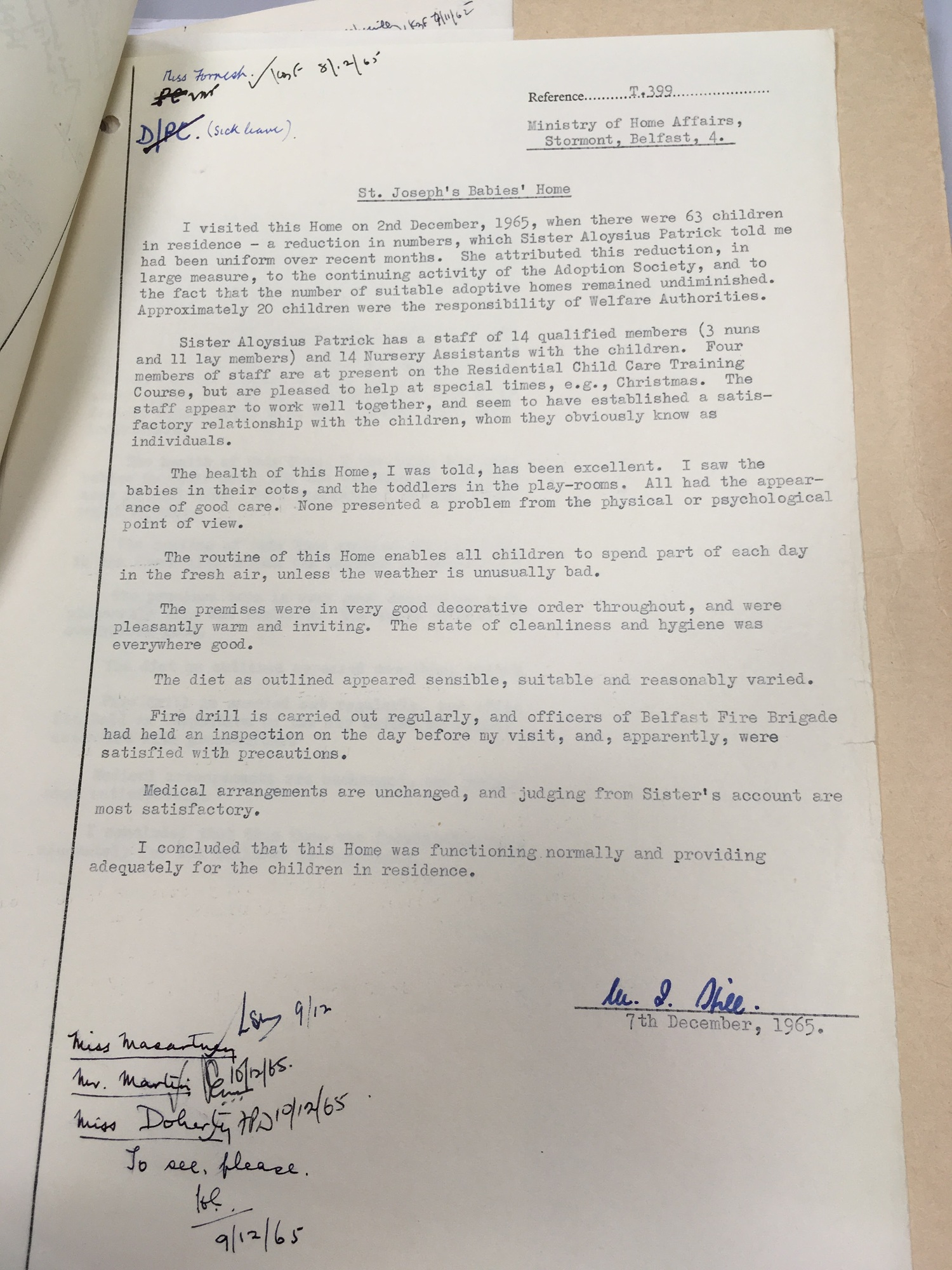DOCUMENTS available to view at the Public Records Office of Northern Ireland (PRONI) provide a window into life in mother and baby homes, as well as the children’s homes where some of the babies moved to after their birth.
Many files have been retained by religious orders and other organisations, but among the papers and files open to the public at PRONI are correspondence with government departments, inspection records and a minute book.
The documents catalogue the trauma suffered by women and children. Pregnant girls as young as 13-years-old were sent into mother and baby homes and there are references to stillbirths and baby deaths. The chairman of one home for unmarried mothers warned in a 1945 letter that the infant mortality figures among illegitimate children “are alarming, leading one to the conclusion that many of these unwanted children are allowed to die.”
We also looked at Welfare Authorities Annual Statistics held by PRONI. This included files containing statistical returns relating to children in care, including at mother and baby homes.
In 1969, for example, 1,644 children were living in care with 633 described as “illegitimate”. Documents show that 499 final adoption orders were granted by the courts in 1969 and 363 children were discharged from care for adoption in the five years 1965-69.
BELFAST MIDNIGHT MISSION
Belfast Midnight Mission for unmarried mothers was based in Malone Place in Belfast.
The admission register for this former mother and baby home is closed to the public. However, we were able to access the home’s minute book (see photograph above) covering the 15 year period from 1934-1949. An Ulster Medical Journal article written in 1986 states that the home, at that time, was under the supervision of Belfast City Council.
The minute book includes a list of key statistics recorded by the staff each month relating to the women and children staying in the home. As well as births to unmarried women, there were also some private patients and babies born to married women.
We looked in detail at the statistics provided in the minutes for meetings which took place in 1948. There were 304 births at the mission in that year alone – at least 141 were to unmarried mothers. There was one maternal death, two stillbirths and one baby died.
In 1948 17 children were adopted, 25 went home with their mother, a further three cases are listed as “home found”, three children were fostered by being “boarded out” [fostered] or "nursed out” and 12 children were sent to other homes (Hopedene, Woodland Avenue and Nazareth Lodge). It is unclear what happened to the remaining children.
Below are extracts from the minute book.
13th November 1934: “In the maternity ward there were 12 girls, 8 babies and 5 private patients. There had been 16 confinements and 9 babies had been boarded out. One baby died aged 2 weeks.”
“There was a boy of 6 years in the Home – a tragic story of a mother who had already paid £28 for its adoption having to take the child back. The matron had views of getting the boy adopted again.”
[The next month’s minutes state that the six-year-old boy had been placed with a foster mother and a man from Barnardo’s Homes had “promised to help”.]
11th November 1936: “There were 12 girls, 9 babies and 5 private patients.”
“6 babies had been boarded out”.
“One girl 15 years of age had twins. Her father was taking charge of this girl and her babies.”
13th January 1937: “In the maternity home there were 11 girls, 1 private patient and 8 babies. There had been 13 confinements and 2 babies died. 16 babies had been boarded out.”
“Twenty girls were in the home at Xmas – two babies had been born on 24th and two on Boxing Day but Xmas had passed quietly and happily. The Home had received £2-15 in money 3 turkeys 2 geese 1 fowl 1 ham 1 ox tongue, vegetables, holly, cakes and shortbread. Fruit loaves, oranges and apples.”
8th December 1937: 20 girls in the home, 7 babies, one baby died aged 16 days, 8 babies boarded out.
“Miss Blackburn reported that one girl in maternity ward was only 14 years of age. The police had her case in hand. She also reported that two men had found a girl of 14 years in a field. The police brought her to the Home. She was very ill with ulcerated legs and had to be removed. She was in ward 15 in the infirmary. Her father was a widower. There were six daughters – two working – this girl was beyond his powers to manage.”
11th January 1939: 18 girls, 10 babies, 1 baby still born, 5 babies boarded out or taken home.
“A baby had been brought to the Home this morning. It had been born this morning in the country and sent to Mr Holmes who brought the child to us. The baby’s mother was 15 years of age and had been at school in Belfast and gone home for Xmas. The matron reported that she had a case coming in of a girl aged 14 years.”
10th January 1940: 24 girls in the home, 19 babies, 8 babies boarded out or taken home.
“Two members of committee told of two cases of girls who had publicly said Malone Place had been the means of their salvation. One girl said this in the Royal Hospital just before an operation. She died. The other was a maid in a clergyman’s house. The latter said ‘she was a blessing to his home’.”
“The matron told of a girl brought to the Home at 5 o’clock one morning – drugged – she was semi-conscious for two days. When examined it was found she was six months pregnant. The matron tried to get her into the Salvation Army Home but was having difficulty in getting the necessary signature. She was applying to an aunt.”
10th September 1941: 16 babies, 1 baby died after 2 days, 1 baby still born.
“The matron reported two cases of abortion and the committee decided that we should call the attention of the medical officer of health to this fact and ask him to take steps in the matter.”
13th May 1942: “There had been more adoptions than usual. The matron was having great difficulty in getting foster mothers. One man who adopted one of the babies had himself been born in the Home 35 years ago. Another baby had been adopted by a clergyman.”
13th September 1944: “1 still birth. 1 baby also died in its 3rd month. Matron reported there would be a marriage in the Home room. There had been 34 illegitimate babies in three months. Miss Jackson agreed to be visitor for the month. The Bible classes were arranged as usual and the meeting closed with prayer.”
8th September 1948: In June, July and August there had been 81 births – 23 to unmarried mothers. 12 babies went home with their mothers, 3 went to Hopedene and there were 6 adoptions.
“Matron reported a case in the Home of a girl of 13 years. Also that the blind girl and her baby had been taken home by her mother.”
HOPEDENE HOSTEL
Another PRONI file holds an appeal for financial assistance which came in September 1945.
In a blue type written letter to the Ministry of Finance, Major David Anderson – chairman of the committee of Hopedene Hostel for unmarried mothers and their children in Belfast – raised concern about “the heavy mortality figures among illegitimate children”.
He asked for “sympathetic attention” to be given to his request for financial assistance for the home established by the Church of Ireland.
Major Anderson said he believed that “for want of proper supervision many unwanted babies die because of the indifference of those who look after them” and this matter alone, he argued, “is worthy of government consideration and enquiry”.
Sentences handwritten in pencil on the back of the Major’s first letter outline the suggested reply from the ministry. This states: “The answer is that whatever personal sympathy we may have, it is impossible for the government to give grants to individual institutions without considering the whole range of similar charities.”
Major Anderson’s appeal for financial support for the home in Dundela Avenue in the Strandtown area of Belfast was rejected by the ministry who suggested that he instead contact the Ministry of Health.
In response, Major Anderson said, as suggested, he would appeal to the Maternity and Child Welfare Committee of the Corporation. But he stressed again that the infantile mortality figures among illegitimate children “are alarming, leading one to the conclusion that many of these unwanted children are allowed to die.”
He said “for this reason alone” he thought some public assistance should be given to Hopedene.
THE SALVATION ARMY
We found a letter in a ‘Department of Prime Minister’ file relating to the Salvation Army in Northern Ireland. Much of the content involved correspondence between the organisation and the PM’s office.
One letter referenced the Salvation Army's Thorndale House – a mother and baby home which was based at Duncairn Avenue in Belfast.
Written in 1959, it states that they “usually have about forty girls in the home and twenty to thirty babies and young children”.
We contacted the Salvation Army but it was unable to provide us with any other statistics or documents relating to its residential units for mothers and babies in Northern Ireland.
A spokesperson on behalf of The Salvation Army told Detail Data: "We were one of a number of churches, charities and social agencies working in partnership with social services and health services and provided residential units for mothers and babies.
“There were extreme social pressures on young women and their families to give a child up for adoption or fostering. Social pressures have evolved, as has the social welfare system.
"Our policy was that adoption outside the birth-family should be a last resort.
"Due to data protection rules we are unable to provide national statistics on the women who stayed in these residential units.
"Our Family Tracing Service has an established track record of finding people and would work to trace individuals and family members if contacted."
The spokesperson added that the Salvation Army would support the call for an inquiry into Northern Ireland’s mother and baby homes.
ST JOSEPH’S BABIES’ HOME, BELFAST (NAZARETH LODGE)
PRONI holds a Department of Health and Social Service’s file relating to St Joseph’s Babies’ Home in south Belfast.
The documents in the file relate mainly to inspections which took place at the home. The dates below refer to the date an inspection took place and the information which follows is contained in notes made after the inspection.
These documents show that between 1964 and 1967 193 children were placed for adoption from this one home alone.
July 14th 1955: concerns were raised about staffing levels in the home. There were 120 babies and 31 lay staff. “I am not happy about the proportion of staff to children in this home,” the notes states. However, it concludes: “In general, however, the lively and responsive attitude of the children is a great credit to the existing staff.”
February 14th 1957: 102 children in the home, the majority were babies. “The lack of speech amongst these children is striking. Even when playing with each other there was no attempt at conversation. We have heard reports from the nursery school too re the lack of speech in the children coming over from the Babies’ House. We have asked Sister to emphasise to the staff the necessity for constant talk when tending to or playing with the children.”
Extract from minutes of a meeting of the Child Welfare Council held on May 12th 1959: Figures were given for the Orphan Society for the year ended 31st March 1959. “In the current year 68 children were admitted to children’s homes; 46 were placed for adoption and 18 were taken back by their mothers. These were all illegitimate children.” It continued: “An intake of 68 and 64 disposed of in the year seems very satisfactory.”
September 22nd 1959: inspectors visited the home to enquire about an outbreak of gastro-enteritis which had led to the death of an eight week old baby. There were 86 babies in residence on the day of their visit.
October 6th 1960: 110 children in residence, 58 under one year old and 52 aged 1 to 3. “All the babies looked healthy, well-nourished and were responsive to a degree seldom seen in institutions of this size.”
May 20th 1964: 75 children in residence. During the current year about 14 children had been placed for adoption. The work of the Adoption Society “continues to flourish”. The admission and discharge register and records of adoption were well maintained.
An inspection note dated 13th April 1965 refers to 75 children being in residence, many of whom were the responsibility of welfare authorities. And: “Sister told me that during the year 1st April 1964 – 31st March 1965, 62 children had been placed for adoption from St Joseph’s and eight older children from Nazareth Lodge.” The relationship between staff and children “seemed a happy one”.
December 1965: There were 63 children in residence – a reduction in numbers which Sister attributed, “in large measure to”, “the continuing activity of the Adoption Society, and to the fact that the number of suitable adoption homes and to the fact that the number of adoptive homes remained undiminished.”
August 1966: There were 62 children in residence and during the year to the end of March, 60 children were placed for adoption.
9th June 1967: The premises were in very good order throughout and the home was well administered. There were 60 children in residence and in the last year 57 children had been placed for adoption. “All the children looked healthy and well cared for.”
16th July 1968: There were 63 children in residence in the age range 0-4 years – “older children having been admitted to keep children together”. About 40 of the children were aged under one. Two babies had died from a respiratory infection “in spite of prompt and efficient treatment”. The document also says that the inspectors were surprised to find that medical records were no longer being kept in the home. The inspectors made it clear that medical records needed to be kept and must be available for inspection.
July 18th 1969: “There were 56 children in residence – many siblings since the ‘single’ children are mostly illegitimate children who are quickly placed for adoption. Sister is well pleased with the type of applicants to adopt and their number.”
Reference numbers for the main items we used at PRONI:
FIN/18/23/208: Ministry of Finance file on ‘Hopedene Hostel – Accommodation for unmarried mothers and their children’.
HA/13/272A: St Joseph's Babies' Home, Ravenhill Road, Belfast (Nazareth Lodge) – Department of Health and Social Services’ inspection file.
D2072/1: Minute book of the Belfast Midnight Mission (Malone Place) June 1934 – October 1949.
HA/13/159A: Department of Health and Social Services file: Welfare Authorities, Annual Statistics, Returns of Children in Care (1960-1969).
PM/6/24: Department of Prime Minister file - The Salvation Army (1923-1943).
MIC1D/91/6: Register of interments in the Roman Catholic Cemetery (Public Ground), Milltown, Belfast (1922-1982). Microfilm only.
- To return to the links for all today's stories, click here.

